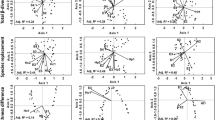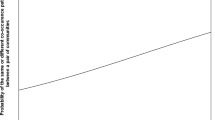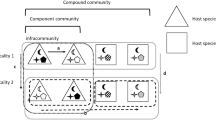Abstract
Beta-diversity of biological communities can be decomposed into (a) dissimilarity of communities among units of finer scale within units of broader scale and (b) dissimilarity of communities among units of broader scale. We investigated compositional, phylogenetic/taxonomic and functional beta-diversity of compound communities of fleas and gamasid mites parasitic on small Palearctic mammals in a nested hierarchy at two spatial scales: (a) continental scale (across the Palearctic) and (b) regional scale (across sites within Slovakia). At each scale, we analyzed beta-diversity among smaller units within larger units and among larger units with partitioning based on either geography or ecology. We asked (a) whether compositional, phylogenetic/taxonomic and functional dissimilarities of flea and mite assemblages are scale dependent; (b) how geographical (partitioning of sites according to geographic position) or ecological (partitioning of sites according to habitat type) characteristics affect phylogenetic/taxonomic and functional components of dissimilarity of ectoparasite assemblages and (c) whether assemblages of fleas and gamasid mites differ in their degree of dissimilarity, all else being equal. We found that compositional, phylogenetic/taxonomic, or functional beta-diversity was greater on a continental rather than a regional scale. Compositional and phylogenetic/taxonomic components of beta-diversity were greater among larger units than among smaller units within larger units, whereas functional beta-diversity did not exhibit any consistent trend regarding site partitioning. Geographic partitioning resulted in higher values of beta-diversity of ectoparasites than ecological partitioning. Compositional and phylogenetic components of beta-diversity were higher in fleas than mites but the opposite was true for functional beta-diversity in some, but not all, traits.






Similar content being viewed by others
References
Adamia S, Zakariadze G, Chkhotua T, Sadradze N, Tsereteli N, Chabukiani A, Gventsadze A (2011) Geology of the the caucasus: a review. Turk J Earth Sci 20:489–544
Anderson MJ, Crist TO, Chase JM, Vellend M, Inouye BD, Freestone AL, Sanders NJ, Cornell HV, Comita LS, Davies KF, Harrison SP, Kraft NJB, Stegen JC, Swenson NG (2011) Navigating the multiple meanings of β diversity: a roadmap for the practicing ecologist. Ecol Lett 14:19–28
Baselga A (2010) Partitioning the turnover and nestedness components of beta diversity. Global Ecol Biogeogr 19:134–143
Baselga A, Jimenez-Valverde A, Niccolini G (2007) A multiple-site similarity measure independent of richness. Biol Lett 3:642–645
Chase JM (2003) Community assembly: when should history matter? Oecologia 136:489–498
Chessel D, Dufour AB, Thioulouse J (2004) The ade4 package-I: one-table methods. R News 4:5–10
Cottenie K (2005) Integrating environmental and spatial processes in ecological community dynamics. Ecol Lett 8:1175–1182
de Bello F, Lavergne S, Meynard CN, Lepš J, Thuiller W (2010) The partitioning of diversity: showing Theseus a way out of the labyrinth. J Veg Sci 21:992–1000
Dray S, Dufour AB, Chessel D (2007) The ade4 package-II: two-table and K-table methods. R News 7:47–52
Edler A, Mehl R (1972) Mites (Acari, Gamasina) from small mammals in Norway. Nor Entomol Tid 19:133–147
Emerson B, Gillespie R (2008) Phylogenetic analysis of community assembly and structure over space and time. Trends Ecol Evol 23:619–630
Foster BL, Questad EJ, Collins CD, Murphy CA, Dickson TL, Smith VH (2011) Seed availability constrains plant species sorting along a soil fertility gradient. J Ecol 99:473–481
Fukami T (2004) Community assembly along a species pool gradient: implications for multiple-scale patterns of species diversity. Pop Ecol 46:137–147
Goncharova AA, Bondarchuk AS, Vershinina ON (1991) Gamasid mites ectoparasites of mammals in Transbaikalia. Chita State Medical University, Chita
Gotelli NJ, Ellison AM (2002) Assembly rules for New England ant assemblages. Oikos 99:591–599
Gower JC (1971) A general coefficient of similarity and some of its properties. Biometrics 27:857–874
Grman E, Brudvig LA (2014) Beta diversity among prairie restorations increases with species pool size, but not through enhanced species sorting. J Ecol 102:1017–1024
Harrison S, Vellend M, Damschen EI (2011) ‘Structured’ beta diversity increases with climatic productivity in a classic dataset. Ecosphere 2:13
Hoberg EP, Brooks DR (2008) A macroevolutionary mosaic: episodic host-switching, geographical colonization and diversification in complex host–parasite systems. Ecol Lett 35:1533–1550
Hoberg EP, Brooks DR (2010) Beyond vicariance: integrating taxon pulses, ecological fitting, and oscillation in evolution and historical biogeography. In: The biogeography of host-parasite interactions, p. In: Morand S, Krasnov BR (eds) The geography of host-parasite interactions. Oxford University Press, Oxford, pp 7–20
Huang L-Q, Guo X-G, Wu D, Zhou D-H (2010) Distribution and ecological niches of gamasid mites (Acari: Mesostigmata) on small mammals in Southwest China. Psyche 2010:1–12
Ioff IG (1941) Ecology of fleas in relevance to their medical importance. Pyatygorsk Publishers, Pyatygorsk
Jost L (2006) Entropy and diversity. Oikos 113:363–375
Korallo NP, Vinarski MV, Krasnov BR, Shenbrot GI, Mouillot D, Poulin R (2007) Are there general rules governing parasite diversity? Small mammalian hosts and gamasid mite assemblages. Divers Distrib 13(3):353–360
Korallo-Vinarskaya NP, Krasnov BR, Vinarski MV, Shenbrot GI, Mouillot D, Poulin R (2009) Stability in abundance and niche breadth of gamasid mites across environmental conditions, parasite identity and host pools. Evol Ecol 23:329–345
Korallo-Vinarskaya NP, Vinarski MV, Khokhlova IS, Krasnov BR (2013) Body size and coexistence in gamasid mites parasitic on small mammals: null model analyses at three hierarchical scales. Ecography 36:508–517
Kraft NJB, Ackerly DD (2011) Disentangling the drivers of beta diversity along latitudinal and elevational gradients. Science 333:1755–1758
Krasnov BR (2008) Functional and evolutionary ecology of fleas. A model for ecological parasitology. Cambridge University Press, Cambridge
Krasnov BR, Shenbrot GI, Khokhlova IS, Poulin R (2004) Relationships between parasite abundance and the taxonomic distance among a parasite’s host species: an example with fleas parasitic on small mammals. Int J Parasitol 34:1289–1297
Krasnov BR, Shenbrot GI, Mouillot D, Khokhlova IS, Poulin R (2005a) Spatial variation in species diversity and composition of flea assemblages in small mammalian hosts: geographic distance or faunal similarity? J Biogeog 32:633–644
Krasnov BR, Shenbrot GI, Khokhlova IS, Poulin R (2005b) Nested pattern in flea assemblages across the host’s geographic range. Ecography 28:475–484
Krasnov BR, Shenbrot GI, Khokhlova IS, Hawlena H, Degen AA (2006a) Temporal variation in parasite infestation of a host individual: does a parasite-free host remain infested permanently? Parasitol Res 99:541–545
Krasnov BR, Stanko M, Miklisova D, Morand S (2006b) Habitat variation in species composition of flea assemblages on small mammals in central Europe. Ecol Res 21:460–469
Krasnov BR, Vinarski MV, Korallo-Vinarskaya NP, Mouillot D, Poulin R (2009) Inferring associations among parasitic gamasid mites from census data. Oecologia 160:175–185
Krasnov BR, Mouillot D, Shenbrot GI, Khokhlova IS, Vinarski MV, Korallo-Vinarskaya NP, Poulin R (2010) Similarity in ectoparasite faunas of Palaearctic rodents as a function of host phylogenetic, geographic, or environmental distances: which matters the most? Int J Parasitol 40:807–817
Krasnov BR, Stanko M, Khokhlova IS, Shenbrot GI, Morand S, Korallo-Vinarskaya NP, Vinarski MV (2011a) Nestedness and beta-diversity in ectoparasite assemblages of small mammalian hosts: effects of parasite affinity, host biology and scale. Oikos 120:630–639
Krasnov BR, Poulin R, Mouillot D (2011b) Scale-dependence of phylogenetic signal in ecological traits of ectoparasites. Ecography 34:114–122
Krasnov BR, Vinarski MV, Korallo-Vinarskaya NP, Khokhlova IS (2013) Ecological correlates of body size in gamasid mites parasitic on small mammals: abundance and niche breadth. Ecography 36:1042–1050
Krasnov BR, Shenbrot GI, Khokhlova IS, Stanko M, Morand S, Mouillot D (2015) Assembly rules of ectoparasite communities across scales: combining patterns of abiotic factors, host composition, geographic space, phylogeny and traits. Ecography 38:184–197
Lehmkuhl F, Owen LA (2005) Late Quaternary glaciation of Tibet and the bordering mountains: a review. Boreas 34:87–100
Leinster T, Cobbold CA (2012) Measuring diversity: the importance of species similarity. Ecology 93:477–489
Loreau M (2000) Are communities saturated? On the relationship between alpha, beta and gamma diversity. Ecol Lett 3:73–76
MacArthur RH (1965) Patterns of species diversity. Biol Rev 40:510–533
Maddison WP, Maddison DR (2011) Mesquite: a modular system for evolutionary analysis, version 2.75. http://mesquiteproject.org
Mašán P, Fenda P (2010) A review of the laelapid mites associated with terrestrial mammals in Slovakia, with a key to the European species (Acari: Mesostigmata: Dermanyssoidea). Institute of Zoology, Slovak Academy of Sciences, Bratislava
Medvedev SG (1996) Geographical distribution of families of fleas (Siphonaptera). Entomol Rev 76:978–992
Morand S, Rohde K, Hayward C (2002) Order in ectoparasite communities of marine fish is explained by epidemiological processes. Parasitology 124:S57–S63
Pavoine S, Dolédec S (2005) The apportionment of quadratic entropy: a useful alternative for partitioning diversity in ecological data. Environ Ecol Stat 12:125–138
Pavoine S, Vallet J, Dufour AB, Gachet S, Daniel H (2009) On the challenge of treating various types of variables: application for improving the measurement of functional diversity. Oikos 118:391–402
Pavoine S, Marcon E, Ricotta C (2016) “Equivalent numbers” for species, phylogenetic or functional diversity in a nested hierarchy of multiple scales. Methods Ecol Evol 7:1152–1163
Questad EJ, Foster BL (2008) Coexistence through spatio-temporal heterogeneity and species sorting in grassland plant communities. Ecol Lett 11:717–726
Radovsky FJ (1985) Evolution of mammalian mesostigmatid mites. In: Kim KC (ed) Coevolution of parasitic arthropods and mammals. John Wiley, New York, pp 441–504
Rao CR (1982a) Diversity and dissimilarity coefficients: a unified approach. Theor Pop Biol 21:24–43
Rao CR (1982b) Diversity: its measurement, decomposition, apportionment and analysis. Sankhyā Ser A 44:1–22
Rao CR (1984) Convexity properties of entropy functions and analysis of diversity. Inequalities in statistics and probability. IMS Lecture Notes Monogr Ser 5:68–77
R Core Team (2016) R: a language and environment for statistical computing. R foundation for statistical computing, Vienna, Austria. https://www.R-project.org/
Ricotta C, Szeidl L (2009) Diversity partitioning of Rao’s quadratic entropy. Theor Pop Biol 76:299–302
Saintot A, Stephenson RA, Stovba S, Brunet MF, Yegorova T, Starostenko V (2006) The evolution of the southern margin of Eastern Europe (Eastern European and Scythian platforms) from the latest Precambrian-Early Palaeozoic to the Early Cretaceous. In: Gee DG, Stephenson RA (eds) European lithosphere dynamics, vol 32. Geological Soc Publishing House, Bath, pp 481–505
Sanders NJ, Gotelli NJ, Wittman SE, Ratchford JS, Ellison AM, Jules ES (2007) Assembly rules of ground-foraging ant assemblages are contingent on disturbance, habitat and spatial scale. J Biogeog 34:1632–1641
Simpson GG (1943) Mammals and the nature of continents. Am J Sci 241:1–31
Storch D (2016) The theory of the nested species–area relationship: geometric foundations of biodiversity scaling. J Veg Sci 27:880–891
Thuiller W, Pollock LJ, Gueguen M, Munkemuller T (2015) From species distributions to meta-communities. Ecol Lett 18:1321–1328
van der Mescht L, Krasnov BR, Matthee CA, Matthee S (2016) Community structure of fleas within and among populations of three closely related rodent hosts: nestedness and beta-diversity. Parasitology 143:1268–1278
Veech JA, Crist TO (2007) Habitat and climate heterogeneity maintain beta-diversity of birds among landscapes within ecoregions. Global Ecol Biogeogr 16:650–656
Vinarski MV, Korallo NP, Krasnov BR, Shenbrot GI, Poulin R (2007) Decay of similarity of gamasid mite assemblages parasitic on Palaearctic small mammals: geographic distance, host species composition or environment? J Biogeog 34:1691–1700
Whittaker RH (1960) Vegetation of the Siskiyou Mountains, Oregon and California. Ecol Monograph 30:280–338
Zemskaya AA (1973) Parasitic gamasid mites and their medical importance. Meditsina, Moscow
Zhu Q, Hastriter MW, Whiting MF, Dittmar K (2015) Fleas (Siphonaptera) are cretaceous, and evolved with Theria. Mol Phylogenet Evol 90:129–139
Acknowledgements
The authors thank the handling editor and two anonymous reviewers for their helpful comments.
Author contribution statement
EMW and BRK conceived of the study. MS, MVV, and NPK collected data. EMW, LVDM, and BRK analyzed data. EMW, LVDM, ISK, and BRK wrote the manuscript. All authors provided editorial advice.
Funding
This study was partly supported by the Israel Science Foundation (Grant Number 26/12 to BRK and ISK), the Scientific Agency of Ministry of Education and Slovak Academy of Sciences (VEGA Project 2/0059/15 to MS), and the Russian Foundation for Basic Research (Project No. 15-44-04030_sibir_a to MVV). EMW received financial support from the United States-Israel Educational Foundation (USIEF Fulbright Post-Doctoral Fellowship) and the Swiss Institute for Dryland Environmental and Energy Research. LVDM received financial support from the Blaustein Center for Scientific Cooperation and the French Associates Institute for Agriculture and Biotechnology of Drylands. This is publication number 928 of the Mitrani Department of Desert Ecology.
Author information
Authors and Affiliations
Corresponding author
Ethics declarations
Conflict of interest
The authors declare that they have no conflict of interest.
Ethical approval
This article relies on previously published data and does not contain experiments with human participants or animals performed by any of the authors.
Additional information
Communicated by George Heimpel.
Electronic supplementary material
Below is the link to the electronic supplementary material.
Rights and permissions
About this article
Cite this article
Warburton, E.M., van der Mescht, L., Stanko, M. et al. Beta-diversity of ectoparasites at two spatial scales: nested hierarchy, geography and habitat type. Oecologia 184, 507–520 (2017). https://doi.org/10.1007/s00442-017-3876-6
Received:
Accepted:
Published:
Issue Date:
DOI: https://doi.org/10.1007/s00442-017-3876-6




